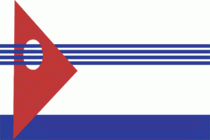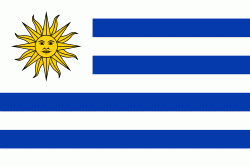Artigas Department (Departamento de Artigas)
 |
 |
It is bordered on the north and east by Brazil, from which it is separated by the Cuareim River. To the south, Artigas Department borders on Salto Department, and to the west is Argentina, from which it is separated by the Uruguay River. Artigas is the only Uruguayan department that borders two other countries.
The department and its capital city are named after José Gervasio Artigas (1764–1850), leader of the Orientales (inhabitants of the Banda Oriental, the Eastern bank of the Uruguay River) during Uruguay's wars of independence.
Owner region of a prehistoric past which later became "no man's land" between the Spanish and Portuguese empires. The initial indigenous predominance (chanás-charrúas-Guarani) was displaced by the native settlement and subsequent colonies of immigrants.
Artigas department was created by law on 1 October 1884, on territory previously belonged to the department of Salto; from that date it is designated to Villa de San Eugenio as capital, which in 1915 passed to the category of city with the name of Artigas, capital of the department with the same name in tribute to the national hero of Uruguay José Gervasio Artigas. He was linked to the fact Colonel Carlos Lecueder, first politician and police chief Artigas. Its capital Artigas comes at the end of the "Guerra Grande" in order to consolidate the borders with Brazil, with the name of San Eugenio del Cuareim. It was founded on September 12, 1852 by Don Carlos Catala, choosing as the best site located on the banks of the Cuareim River opposite the Villa San Juan Bautista on the other side of the river, which was a military settlement that was then transformed into what is today the city of Quaraí.
With the name of Santa Rosa del Cuareim was founded the current Bella Union by Fructuoso Rivera and refugees Guarani after the campaign Eastern Missions against Brazil in 1829. In 1852 after winning the allies Colorados Brazil national, territory north of Cuareim was yielded to Brazil which prompted an evacuation of the population. It was refounded in 1853 under the name of Santa Rosa de la Bella Union Quareim. In 1929 the national government to mark the centenary of the campaign of Missions, sent a bill to the Senate, which established the name Bella Union, which for that time was a villa.
Map - Artigas Department (Departamento de Artigas)
Map
Country - Uruguay
 |
 |
| Flag of Uruguay | |
The area that became Uruguay was first inhabited by groups of hunter–gatherers 13,000 years ago. The predominant tribe at the moment of the arrival of Europeans was the Charrúa people, when the Portuguese first established Colónia do Sacramento in 1680; Uruguay was colonized by Europeans late relative to neighboring countries. The Spanish founded Montevideo as a military stronghold in the early 18th century because of the competing claims over the region. Uruguay won its independence between 1811 and 1828, following a four-way struggle between Portugal and Spain, and later Argentina and Brazil. It remained subject to foreign influence and intervention throughout the 19th century, with the military playing a recurring role in domestic politics. A series of economic crises and the political repression against left-wing guerrilla activity in the late 1960s and early 1970s put an end to a democratic period that had begun in the early 20th century, culminating in the 1973 coup d'état, which established a civic-military dictatorship. The military government persecuted leftists, socialists, and political opponents, resulting in deaths and numerous instances of torture by the military; the military relinquished power to a civilian government in 1985. Uruguay is today a democratic constitutional republic, with a president who serves as both head of state and head of government.
Currency / Language
| ISO | Currency | Symbol | Significant figures |
|---|---|---|---|
| UYU | Uruguayan peso | $ | 2 |
| ISO | Language |
|---|---|
| ES | Spanish language |
















